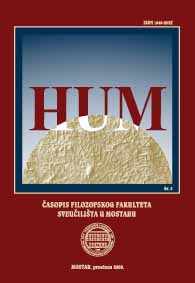LJUBIĆEVA POVIJEST KNJIŽEVNOSTI I HRVATI NA GRADIŠĆANSKOHRVATSKOME GOVORNOM PODRUČJU
LJUBIĆ’S HISTORY OF LITERATURE AND CROATS IN THE BURGENLAND-CROATIAN SPEAKING AREA
Author(s): Andrea Sapunar KneževićSubject(s): Literary Texts
Published by: Filozofski fakultet Sveučilišta u Mostaru
Keywords: literary history; Šime Ljubić; Burgenland Croats; kajkavian literature.
Summary/Abstract: In “Ogledalo književne poviesti jugoslavjanske na podučavanje mladeži” (book II, 1869) Šime Ljubić, Croatian literary historian, considers Croatian authors from the area of west Hungary and Lower Austria, today Burgenland-Croatian area, as kajkavian writers and calls them “literature written in the kajkavian dialect”. Ljubić puts kajkavian and Croatian literature of West-Hungarian area under the same name, especially because he thinks that Croatian authors from the West-Hungarian region write the same for Kajkavians, but Hungarian Kajkavians. With genre, content and style characteristics Burgenland-Croatian literature is close to a part of kajkavian literature of the 17th and 18th century. According to those criteria we could unite them into a whole, but that cannot be done as far as language is concerned. Burgenland Croats use chakavian and stokavian dialect, and there is a small number of Kajkavians among them. In the entire area, which is considered as Burgenland in dialectal sense, there is only one speech of two villages Vedešin and Umok (Hidegség and Fertőhomok) in the West Hungary near Šapron, which could be considered kajkavian, although it is not typically kajkavian. The most numerous are chakavian speeches and chakavian dialect or ikavian-ekavian speeches of the North and Central Burgenland became the basis of Burgenland-Croatian (standard) language. An answer to the question why Šime Ljubić considers Croats of West-Hungarian region and Lower Austria as Hungarian Kajkavians should be looked for in the fact that the first results of more serious and systematic analyses of language and culture of West-Hungarian and Lower-Austrian Croats were published right after Ljubić’s “Ogledalo književne poviesti jugoslavjanske” (1869). Sources, which Ljubić used the most, were two books: “Bibliografia hrvatska” from 1860 written by Ivan Kukuljević Sakcinski and “Geschichte der südslawischen Literatur (Geschichte der ilirischen and kroatischen Literatur)” written by Paul Josef Šafařík, published in Prague in 1865. Ljubić took over data from the mentioned literature, mostly without having checked their correctness. Ljubić’s piece of work stands in the very beginning of the Croatian literary history and it should be considered in the context of time in which it was made. His aim was “to clear the way” to successors who will further build literary history. Although his work in some of its propositions is not relevant to the current literary history, it is the best witness of its beginnings and it is important base of further development of literary history.
Journal: Hum
- Issue Year: 2009
- Issue No: 5
- Page Range: 162-180
- Page Count: 19
- Language: Croatian

